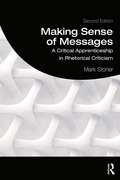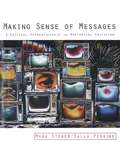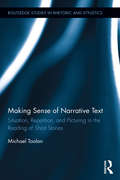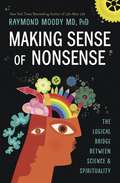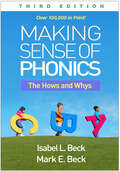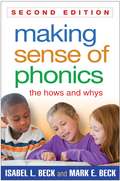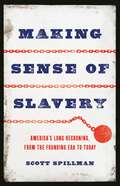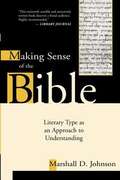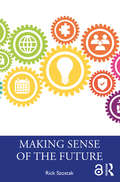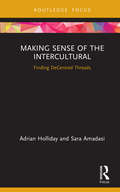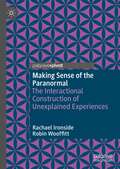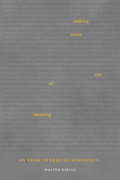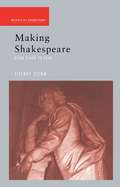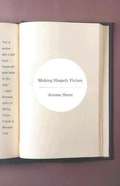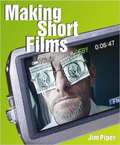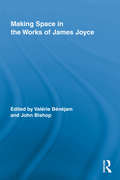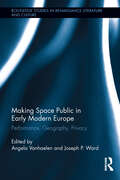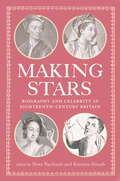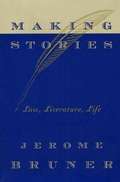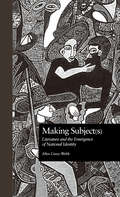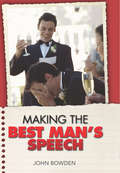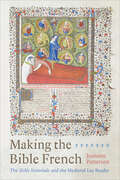- Table View
- List View
Making Sense of Messages: A Critical Apprenticeship in Rhetorical Criticism
by Mark StonerMaking Sense of Messages, now in its second edition, retains the apprenticeship approach which facilitates effectively learning the complex content and skills of rhetorical theory and criticism. A new chapter on “The Rhetoric of Ignorance” provides needed theory and examples that help students deal with the new rhetorical landscape marked by such discursive complexities as “fake news,” “whataboutism,” and denial of science that creates rather than reduces uncertainty in public argument. A new chapter, “Curating and Analyzing Multimodal Mediated Rhetoric,” deals with problems of media criticism in the digital age. It provides theory, models of application, and commentary that help novice critics understand and mindfully practice criticism that leads to insight, not mere opinion. Throughout the book, extended and updated examples and commentaries are designed to promote "novice-to-expert" agency in students. This textbook is ideal for introductory courses in contemporary rhetoric, rhetorical criticism, and critical analysis of mass media.
Making Sense of Messages: A Critical Apprenticeship in Rhetorical Criticism
by Mark Stoner Sally J. PerkinsUsing a developmental approach to the process of criticism, Making Sense of Messages serves as an introduction to rhetorical criticism for communication majors. The text employs models of criticism to offer pointed and reflective commentary on the thinking process used to apply theory to a message. This developmental/apprenticeship approach helps students understand the thinking process behind critical analysis and aids in critical writing.
Making Sense of Narrative Text: Situation, Repetition, and Picturing in the Reading of Short Stories (Routledge Studies in Rhetoric and Stylistics #11)
by Michael ToolanThis book takes the following question as its starting point: What are some of the crucial things the reader must do in order to make sense of a literary narrative? The book is a study of the texture of narrative fiction, using stylistics, corpus linguistic principles (especially Hoey’s work on lexical patterning), narratological ideas, and cognitive stylistic work by Werth, Emmott, and others. Michael Toolan explores the textual/grammatical nature of fictional narratives, critically re-examining foundational ideas about the role of lexical patterning in narrative texts, and also engages the cognitive or psychological processes at play in literary reading. The study grows out of the theoretical questions that stylistic analyses of extended fictional texts raise, concerning the nature of narrative comprehension and the reader’s experience in the course of reading narratives, and particularly concerning the role of language in that comprehension and experience. The ideas of situation, repetition and picturing are all central to the book’s argument about how readers process story, and Toolan also considers the ethical and emotional involvement of the reader, developing hypotheses about the text-linguistic characteristics of the most ethically and emotionally involving portions of the stories examined. This book makes an important contribution to the study of narrative text and is in dialogue with recent work in corpus stylistics, cognitive stylistics, and literary text and texture.
Making Sense Of Nonsense: The Logical Bridge Between Science And Spirituality
by Raymond MoodyWhat do the whimsical writings of Dr. Seuss have in common with near-death experiences? The answer is that nonsense writing and spiritual experiences seem to defy all logic and yet they both can make a powerful personal impact. In this book, New York Times bestselling author Dr. Raymond Moody shares the groundbreaking results of five decades of research into the philosophy of nonsense, revealing dynamic new perspectives on language, logic, and the mystical side of life. Explore the meaningful feelings that accompany nonsense language and learn how engaging with nonsense can help you on your own spiritual path. Discover how nonsense transcends classical logic, opening the doorway to new spiritual and philosophical breakthroughs. With dozens of examples from literature, comedy, music, and the history of religion, this book presents a unique new approach to the mysteries of the human spirit.
Making Sense of Phonics: The Hows and Whys
by Isabel L. Beck Mark E. BeckNow in a revised and updated third edition incorporating a decade of additional research and classroom experience, this book has helped over 100,000 primary-grades teachers understand and successfully apply the science of reading in phonics instruction. Isabel L. Beck and Mark E. Beck present innovative approaches to assessing and teaching letter–sound relationships, blending, Word Building, multisyllabic decoding, fluency, and more. A wealth of reproducible forms and word lists can be copied from the book or downloaded and printed; the companion website also features supplemental word lists, word and syllable cards, and 30 illustrated Syllasearch stories. Engaging teacher anecdotes and end-of-chapter "Your Turn" activities enhance the book's utility as a professional development resource and course text. New to This Edition *Chapter on the key role of phonics in today's literacy programs--with a focus on what is needed for high-quality instruction aligned with the science of reading. *Chapter on extending Word Building instruction to small groups and individual students. *Extensive revision of the Syllasearch activity for decoding multisyllabic words. *Expanded reproducible and downloadable tools, including enhanced Word Building lists, new Syllasearch lists (with teaching tips), and eight new Syllasearch stories.
Making Sense of Phonics: The Hows and Whys
by Isabel L. Beck; Mark E. BeckThis bestselling book provides indispensable tools and strategies for explicit, systematic phonics instruction in K-3. Teachers learn effective ways to build students' decoding skills by teaching letter-sound relationships, blending, word building, multisyllabic decoding, fluency, and more.
Making Sense of Slavery: America's Long Reckoning, from the Founding Era to Today
by Scott SpillmanAn &“essential&” (James Oakes, author of The Crooked Path to Abolition) history of the study of slavery in America, from the Revolutionary era to the 1619 Project, showing how these intellectual debates have shaped American public life In recent years, from school board meetings to the halls of Congress, Americans have engaged in fierce debates about how slavery and its legacies ought to be taught, researched, and narrated. But since the earliest days of the Republic, political leaders, abolitionists, judges, scholars, and ordinary citizens have all struggled to explain and understand the peculiar institution. In Making Sense of Slavery, historian Scott Spillman shows that the study of slavery was a vital catalyst for the broader development of American intellectual life and politics. In contexts ranging from the plantation fields to the university classroom, Americans interpreted slavery and its afterlives through many lenses, shaping the trajectory of disciplines from economics to sociology, from psychology to history. Spillman delves deeply into the archives, and into the pathbreaking work of scholars such as W. E. B. Du Bois and Annette Gordon-Reed, to trace how generations of Americans have wrestled with the paradox of slavery in a country founded on principles of liberty and equality. As the debate over the place of slavery in our history rages on, Making Sense of Slavery shows that what is truly central to American history is this very debate itself.
Making Sense of the Bible: Literary Type as an Approach to Understanding
by Marshall D. JohnsonFocusing on the eight major literary forms in the Bible -- wisdom literature, liturgical materials, quasi-historical material, prophetic writings, collections of laws and precepts, apocalyptic literature, letters, and Gospels -- Johnson describes each form's central features and gives readers a sense of what to expect from each literary form and how to approach it.
Making Sense of the Future
by Rick SzostakMaking Sense of the Future integrates the latest thinking in Future Studies with the author’s expertise in world history, economics, interdisciplinary studies, knowledge organization, and political activism. The book takes a systems approach that recognizes the complexity of our world. It begins by suggesting a set of goals for human societies and identifying innovative strategies for achieving these goals that could gain broad support. Each chapter begins with a “How to” section that discusses how we can identify goals, strategies, trends, surprises, or implementation strategies and concludes with an integrative analysis that draws connections across the preceding discussions. Taking a cross-disciplinary approach, Szostak explores key trends and how these interact so that he can develop strategies to guide trends towards desirable futures. He discusses the ways in which we can best prepare for surprises such as epidemics and natural disasters, enabling us to react to them in beneficial ways. Supported by a list of guiding questions and suggestions for class projects, this is an accessible textbook for students of Future Studies and Future Studies courses.
Making Sense of the Intercultural: Finding DeCentred Threads (Routledge Focus on Linguistics)
by Adrian Holliday Sara AmadasiIn this book we wish to find a new way of talking about, connecting and operationalising the third space, narratives, positioning, and interculturality. Our purpose is to shake established views in what we consider to be an urgent quest for dealing with prejudice. We therefore seek to draw attention to the following: How Centre structures and large culture boundaries are sources of prejudice How deCentred intercultural threads address prejudice by dissolving these boundaries How, in everyday small culture formation on the go, the cultural and the intercultural are observable and become indistinguishable How agency, personal and grand narratives, discourses, and positioning become visible in unexpected ways How we researchers also bring competing narratives in making sense of the intercultural How third spaces are discordant and uncomfortable places in which all of us must struggle to achieve interculturality This book is therefore a journey of discovery with each chapter building on the previous ones. While throughout there are particular empirical events (interviews, reconstructed ethnographic accounts and research diary entries) with their own detailed analyses and insights, they connect back to discussion in previous chapters.
Making Sense of the Paranormal: The Interactional Construction of Unexplained Experiences
by Robin Wooffitt Rachael IronsideThis book is a study of how people collaboratively interpret events or experiences as having paranormal features, or as evidence of spiritual agency. The authors study recordings of paranormal research groups as they conduct real life investigations into allegedly haunted spaces and the analyses describe how, through their talk and embodied actions, participants collaboratively negotiate the paranormal status of the events they experience.By drawing on the study of the social organisation in everyday interaction, they show how paranormal interpretations may be proposed, contested and negotiated through conversational and embodied practices of the group. The book contributes to the sociology of anomalous experience, and explores its relevance to other social science topics such as dark tourism, participation in religious spaces and practices, and the attribution of agency. This book will therefore be of interest to academics and postgraduate researchers of language and social interaction; discourse and communication, cultural studies; social psychology, sociology of religious experience; parapsychology, communication and psychotherapy.
Making Sense Out of Meaning: An Essay in Lexical Semantics
by Walter HirtleIn his exploration of word meaning, Walter Hirtle examines an important and controversial topic in lexical semantics: polysemy, the capacity of words to manifest a range of different meanings when employed in different contexts. Building on the work of French linguist Gustave Guillaume, Making Sense out of Meaning is a speaker-oriented study that describes how speakers form word meaning and not, as in other theories, how listeners interpret the meaning of what they hear. Hirtle develops a general model of the ways in which words and word meaning may be realized in discourse contexts and addresses such issues as the demarcation of polysemy and monosemy, metaphorical meaning, parts of speech, and the concept of conversion or zero derivation. Bringing together both lexical and grammatical components, Hirtle shows that distinct lexical senses can be observed and their relations can be understood by focusing on speakers' use of verbs and nouns. A methodical and thoughtful work, Making Sense out of Meaning situates its central question by recalling traditional views of language’s relation to thought and argues for meaning as a valid object of scientific inquiry.
Making Sense out of Meaning: An Essay in Lexical Semantics
by Walter HirtleIn his exploration of word meaning, Walter Hirtle examines an important and controversial topic in lexical semantics: polysemy, the capacity of words to manifest a range of different meanings when employed in different contexts. Building on the work of French linguist Gustave Guillaume, Making Sense out of Meaning is a speaker-oriented study that describes how speakers form word meaning and not, as in other theories, how listeners interpret the meaning of what they hear. Hirtle develops a general model of the ways in which words and word meaning may be realized in discourse contexts and addresses such issues as the demarcation of polysemy and monosemy, metaphorical meaning, parts of speech, and the concept of conversion or zero derivation. Bringing together both lexical and grammatical components, Hirtle shows that distinct lexical senses can be observed and their relations can be understood by focusing on speakers' use of verbs and nouns. A methodical and thoughtful work, Making Sense out of Meaning situates its central question by recalling traditional views of language’s relation to thought and argues for meaning as a valid object of scientific inquiry.
Making Shakespeare: From Stage to Page (Accents on Shakespeare)
by Tiffany SternMaking Shakespeare is a lively introduction to the major issues of the stage and print history, whilst also raising questions about what a Shakespeare play actually is. Tiffany Stern reveals how London, the theatre, the actors and the way in which the plays were written and printed all affect the 'Shakespeare' that we now read. Concentrating on the instability and fluidity of Shakespeare's texts, her book discusses what happened to a manuscript between its first composition, its performance on stage and its printing, and identifies traces of the production system in the plays we read. She argues that the versions of Shakespeare that have come down to us have inevitably been formed by the contexts from which they emerged; being shaped by, for example, the way actors received and responded to their lines, the props and music used in the theatre, or the continual revision of plays by the playhouses and printers. Allowing a fuller understanding of the texts we read and perform, Making Shakespeare is the perfect introduction to issues of stage and page. A refreshingly clear, accessible read, this book will allow even those with no expert knowledge to begin to contextualize Shakespeare's plays for themselves, in ways both old and new.
Making Shapely Fiction
by Jerome SternA deft analysis and appreciation of fiction--what makes it work and what can make it fail. Here is a book about the craft of writing fiction that is thoroughly useful from the first to the last page--whether the reader is a beginner, a seasoned writer, or a teacher of writing. You will see how a work takes form and shape once you grasp the principles of momentum, tension, and immediacy. "Tension," Stern says, "is the mother of fiction. When tension and immediacy combine, the story begins." Dialogue and action, beginnings and endings, the true meaning of "write what you know," and a memorable listing of don'ts for fiction writers are all covered. A special section features an Alphabet for Writers: entries range from Accuracy to Zigzag, with enlightening comments about such matters as Cliffhangers, Point of View, Irony, and Transitions.
Making Shapely Fiction
by Jerome SternJerome Stern maintains that learning to write spontaneously is the first step to writing well. You will see how a work takes form and shape once you grasp the principles of momentum, tension, and immediacy. "Tension," Stern says, "is the mother of fiction. When tension and immediacy combine, the story begins." Dialogue and action, beginnings and endings, the true meaning of "write what you know," and a memorable listing of don'ts for fiction writers are all covered. A special section features an Alphabet for Writers: entries range from Accuracy to Zigzag, with enlightening comments about such matters as Cliffhangers, Point of View, Irony, and Transitions.
Making Short Films
by Jim PiperAccompanying DVD of thirty short films offers an instructive mini film festival Shows beginners how to make meaningful films without fancy equipment Great for film students and independent filmmakers Want to make an art film, a documentary, a video biography? Here’s how to create real movies using consumer digital video format-without spending a lot of money or time. Author Jim Piper has taught filmmaking for more than thirty years-and along with his technical expertise, he brings entertaining anecdotes and great examples. His descriptions of more than one hundred student films, illustrated with three hundred stills, offer inspiration for beginners, and the accompanying DVD showcases thirty examples that comprise an intriguing and instructive mini film festival.Allworth Press, an imprint of Skyhorse Publishing, publishes a broad range of books on the visual and performing arts, with emphasis on the business of art. Our titles cover subjects such as graphic design, theater, branding, fine art, photography, interior design, writing, acting, film, how to start careers, business and legal forms, business practices, and more. While we don't aspire to publish a New York Times bestseller or a national bestseller, we are deeply committed to quality books that help creative professionals succeed and thrive. We often publish in areas overlooked by other publishers and welcome the author whose expertise can help our audience of readers.
Making Space in the Works of James Joyce (Routledge Studies in Twentieth-Century Literature)
by Valérie Bénéjam John BishopJames Joyce’s preoccupation with space—be it urban, geographic, stellar, geometrical or optical—is a central and idiosyncratic feature of his work. In Making Space in the Works of James Joyce, some of the most esteemed scholars in Joyce studies have come together to evaluate the perception and mental construction of space, as it is evoked through Joyce’s writing. The aim is to bring together several recent trends of literary research and criticism to bear on the notion of space in its most concrete sense. The essays move dialectically out of an immediate focus on the phenomenological and intra-psychic, into broader and wider meditations on the social, urban and collective. As Joyce’s formal experiments appear the response to the difficulty of enunciating truly the experience of lived space, this eventually leads us to textual and linguistic space. The final contribution evokes the space with which Joyce worked daily, that of his manuscripts—or what he called "paperspace." With essays addressing all of Joyce's major works, this volume is a critical contribution to our understanding of modernism, as well as of the relationship between space, language, and literature.
Making Space Public in Early Modern Europe: Performance, Geography, Privacy (Routledge Studies in Renaissance Literature and Culture #Vol. 23)
by Joseph P. Ward Angela VanhaelenBroadening the conversation begun in Making Publics in Early Modern Europe (2009), this book examines how the spatial dynamics of public making changed the shape of early modern society. The publics visited in this volume are voluntary groupings of diverse individuals that could coalesce through the performative uptake of shared cultural forms and practices. The contributors argue that such forms of association were social productions of space as well as collective identities. Chapters explore a range of cultural activities such as theatre performances; travel and migration; practices of persuasion; the embodied experiences of lived space; and the central importance of media and material things in the creation of publics and the production of spaces. They assess a multiplicity of publics that produced and occupied a multiplicity of social spaces where collective identity and voice could be created, discovered, asserted, and exercised. Cultural producers and consumers thus challenged dominant ideas about just who could enter the public arena, greatly expanding both the real and imaginary spaces of public life to include hitherto excluded groups of private people. The consequences of this historical reconfiguration of public space remain relevant, especially for contemporary efforts to meaningfully include the views of ordinary people in public life.
Making Stars: Biography and Celebrity in Eighteenth-Century Britain (Performing Celebrity)
by Stuart Sherman Semane Parsons Heather McPherson Sören Hammerschmidt Kevin Bourque Glynis Ridley Jack Lynch Elaine McGirr Sarah Ailwood Anne Betty Weinshenker Rebecca Tierney-Hynes Miriam L. Wallace Teri Doerksen Kirsten Teresa Saxton Jane WesselIn bringing biography and celebrity together, the essays in Making Stars interrogate contemporary and current understandings of each. Although biography was not invented in the eighteenth century, the period saw the emergence of works that focus on individuals who are interesting as much, if not more, for their everyday, lived experience than for their status or actions. At the same time, celebrity emerged as public fascination for the private lives of publicly visible individuals. Biography and celebrity are mutually constitutive, but in complex and varied ways that this volume unpacks. Contributors to this volume present us a picture of eighteenth-century celebrity that was mediated across multiple sites, demonstrating that eighteenth-century celebrity culture in Britain was more pervasive, diverse and, in many ways, more egalitarian, than previously supposed.
Making Stories: Law, Literature, Life
by Jerome S. BrunerStories pervade our daily lives, from human interest news items, to a business strategy described to a colleague, to daydreams between chores. Stories are what we use to make sense of the world. But how does this work? In Making Stories, the eminent psychologist Jerome Bruner examines this pervasive human habit and suggests new and deeper ways to think about how we use stories to make sense of lives and the great moral and psychological problems that animate them. Looking at legal cases and autobiography as well as literature, Bruner warns us not to be seduced by overly tidy stories and shows how doubt and double meaning can lie beneath the most seemingly simple case.
Making Subject: Literature and the Emergence of National Identity (Comparative Literature and Cultural Studies #4)
by Allen Carey-WebbFirst published in 1998. Routledge is an imprint of Taylor & Francis, an informa company.
Making the Best Man's Speech
by John BowdenThis is a guide for prospective "best men" which aims to answer the anxieties about making the speech. It offers advice on speech-making essentials, great openings, strong middles, big finishes, plus putting it all together and delivering the speech itself.
Making the Best Man's Speech
by John BowdenThis is a guide for prospective "best men" which aims to answer the anxieties about making the speech. It offers advice on speech-making essentials, great openings, strong middles, big finishes, plus putting it all together and delivering the speech itself.
Making the Bible French: The Bible historiale and the Medieval Lay Reader
by Jeanette PattersonFrom the end of the thirteenth century to the first decades of the sixteenth century, Guyart des Moulins’s Bible historiale was the predominant French translation of the Bible. Enhancing his translation with techniques borrowed from scholastic study, vernacular preaching, and secular fiction, Guyart produced one of the most popular, most widely copied French-language texts of the later Middle Ages. Making the Bible French investigates how Guyart’s first-person authorial voice narrates translation choices in terms of anticipated reader reactions and frames the biblical text as an object of dialogue with his readers. It examines the translator’s narrative strategies to aid readers’ visualization of biblical stories, to encourage their identification with its characters, and to practice patient, self-reflexive reading. Finally, it traces how the Bible historiale manuscript tradition adapts and individualizes the Bible for each new intended reader, defying modern print-based and text-centred ideas about the Bible, canonicity, and translation.
